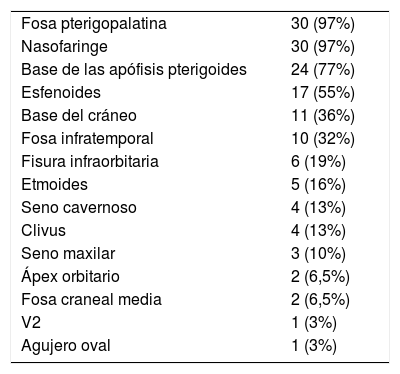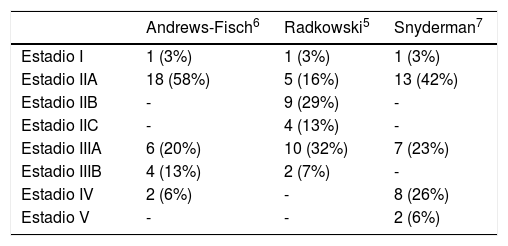Los angiofibromas juveniles (AJ) son tumores benignos cuyo tratamiento de elección es la cirugía. Dada su localización y su comportamiento expansivo pueden generar una elevada morbilidad. Tienen gran tendencia al sangrado y su tratamiento es complejo. El manejo de los AJ ha cambiado, pero continúa siendo un reto. El objetivo de este estudio fue revisar a una serie de pacientes con AJ tratados mediante un abordaje endonasal endoscópico endonasal.
Material y métodosSe revisaron las historias médicas de todos los pacientes con AJ intervenidos mediante un abordaje endoscópico endonasal. Las principales variables estudiadas incluyeron el estadio tumoral, la pérdida de sangre intraoperatoria, la tasa de complicaciones y la tasa de persistencia o recidiva.
ResultadosSe incluyeron un total de 31 pacientes, 30 varones y una mujer. La edad media fue de 17 años. Según la clasificación de Radkowski, un caso pertenecía al estadio I, 5 al estadio IIA, 9 al estadio IIB, 4 al estadio IIC, 10 al estadio IIIA y 2 al estadio IIIB. El 39% de los AJ pertenecían a estadios avanzados (IIIA y IIIB). La pérdida media de sangre fue de 1.156ml. Excepto en un caso, no se observaron complicaciones significativas. La tasa de persistencia/recurrencia al finalizar el seguimiento fue del 6% (2 AJ en estadio avanzado). El seguimiento medio fue de 86 meses.
ConclusionesEste estudio retrospectivo respalda que la opción de los abordajes endoscópicos endonasales para el tratamiento de los AJ es factible y se asocia con buenos resultados a largo plazo.
Juvenile angiofibroma (JA) is a benign tumour, for which the treatment of choice is surgery. It may be associated with significant morbidity because of its anatomical location and its locally destructive growth pattern. Severe haemorrhage constitutes a high risk in JA and its surgical management can be complex. The management of JA remains a challenge. The objective of this study was to review a series of patients with JA treated via the endonasal/endoscopic approach.
Material and methodsMedical records of patients operated for JA were reviewed. Main outcome measures: tumour stage, intraoperative blood loss, complications and persistence/recurrence rates.
ResultsA total of 30 male patients and one female were included. The mean age was 17 years. Using the Radkowski classification, one JA was classified as stage I, 5 stage IIA, 9 stage IIB, 4 stage IIC, 10 stage IIIA and 2 stage IIIB. Thirty-nine percent of the JA was classified as advanced stage JA (IIIA and IIIB). The mean blood loss was 1.156mL Except in one case, no significant complications were observed. Tumour persistence/recurrence was observed in 2 JA (6%), at the end of the follow-up. Mean postoperative follow-up time was 86 months.
ConclusionsThis retrospective study supports the notion that endonasal endoscopic approaches for a JA are a feasible option associated with good long-term results.











